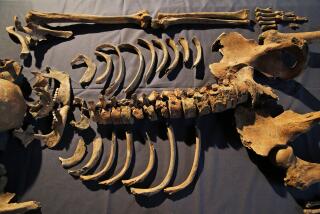The Long History of Cancer in Humans
- Share via
We will never know if in life he was a noble or serf, or if she was a military wife or handmaiden. We do know that the skeletons of the young Saxon exhumed in Oxfordshire, England, and the Roman woman unearthed in Juellinge, Denmark, had large tumors on their legs that were probably malignancies and may have caused their deaths.
These skeletons and scores of others are the focus of a new kind of forensic research. “Paleo-oncology: the Antiquity of Cancer,” just published in London by Farrand Press, describes what physicians, anthropologists and paleontologists have learned about cancer in the human past. The editor, Spyros Retsas, recalls that cancer is no new disease. Moreover cancer afflicts most other animals and even some plant life. The earliest evidence of a malignancy in early man, according to George P. Stathopoulos of the University of Athens, is the Kamanmandibular fragment, a piece of jawbone that was found in 1932 by Louis Leakey in Kenya. Somewhere between half a million and 2 million years old, the bone has all the markings of either a sarcoma or Burkitt’s lymphoma.
Archeologists and anthropologists have collected skeletal and mummified human remains for more than a century. Now paleo-oncologists are reexamining those in museum collections with X-rays, CAT-scans and cell biological techniques. All cancers do not leave traces. Soft tissue and fluids usually decay. But cancer changes the structure of afflicted bones that it turns into porous, spongy material, or, in the case of tumors, distorts the shapes of the bones themselves. Paleo-oncologists have found that a skull in the museum of the University of Copenhagan harbored a tumor stretching from the nasal cavity across the whole left sinus. In the Museum of Anthropology in San Diego’s Balboa Park, they have found a pre-Columbian skull from Peru with a diseased area in the right frontal bone as well as what looks like the remnants of a soft tumor at the base of the skull.
Most of the ancient record is skulls and bones. But occasionally soft tissue miraculously survives. In 1826 a British surgeon dissected a female Egyptian mummy and discovered the right ovary immersed in a mass of diseased tissue. He diagnosed the enlarged uterus and connecting material as ovarian dropsy, which sounds, in today’s medical idiom like uterine cancer.
In their search for evidence, medical historians have supplemented the evidence from actual remains with an analysis of the writings of ancient Egyptian and Greek physicians. The Egyptians did not have a word for cancer, but they did use the terms swellings and tumors to describe growths the sizes of familiar objects like fruits. The word cancer was coined by Galen, the Greek who gained fame as the personal physician to the Roman Emperor Marcus Aurelius. Galen thought that the distorted veins stretched by the unnatural tumor on a woman’s breast looked like a crab with its legs spread on either side of its body, so he called the disease a cancer, which is Latin for crab.
The discovery of instances and even patterns of cancer in antiquity provides an important perspective on the way we approach the disease ourselves. People seem to have suffered from malignant tumors of the skull, the femur and the reproductive organs throughout history. There is little record, however, of some of the other kinds of cancers that rage today such as cancers of the lungs and the intestinal tract.
To some degree, cancers are a luxury of longevity. More people suffer with cancer today because people are outliving the injuries and diseases that shortened the lives of our ancestors. However, it is also true that the chemical and nuclear pollution of our modern environment has contributed to high rates of special kinds of cancers such as leukemia, liver and pancreatic cancer. But the authors of this collection remind us that some of today’s most common cancers, such as breast cancer, were common in the past and have prevailed through the centuries among peoples with varied diets in different places. They also point out that extensive fossil evidence of naso-pharyngeal cancers in ancient Africa are the same kind of cancer still endemic on that continent.
In looking for causes and treatments of cancer, an exploration into the history of the disease can be useful. While industrial pollution and longevity may be responsible for the increased rates of some forms of the disease, the prevalence of other kinds of cancer over time is reason to look at geographical and genetic causes as well as the possibility that pernicious cell mutations are a consequence of some of the changes inherent in the aging process. As historically oriented coroners utilize increasingly better diagnostic tools, they should be able to trace a clearer pattern of the history of the disease.




